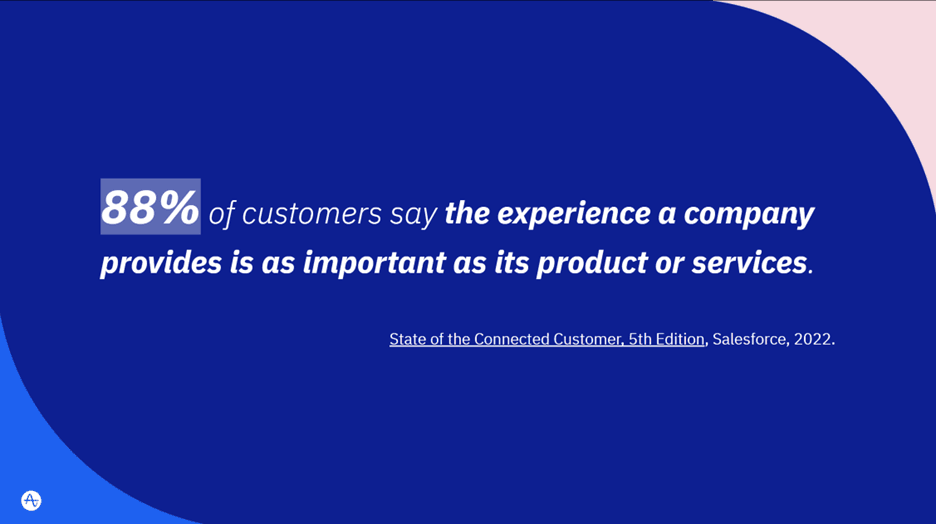Improve Customer Experience with These 3 Tips
Identify customer experience pain points and develop strategies for offering a better experience with these proven tips.
Three essential tips to improve your customer experience include personalizing customer interactions across all touchpoints, upgrading your customer service tech stack, and implementing post-sale support services.
Customers today have more choice and voice than ever, so slacking on customer experience is not an option. Between December 2021 and February 2022, Salesforce surveyed over 13,000 consumers from across the globe and found that 88% feel the experience a company provides is as important as its product or services, and 56% expect personalization on all offers. Emplifi also reported that 49% of consumers left a brand to which they’d been loyal in the past 12 months due to poor customer experience.
Your customer experience (CX) starts long before a customer places an order or calls customer service—it starts the moment a customer discovers your brand. To create and keep your customers’ loyalty, you must meet their customer experience expectations. Customers are, after all, the heart and soul of your business.

Key takeaways
- Identify pain points in your current customer journey to understand your brand's customer experience.
- Use qualitative and quantitative research data, customer feedback, online reviews, and input from customer service teams to contextualize those pain points.
- Three key ways to improve your customer experience include personalizing customer interactions across all touchpoints, upgrading your customer service tech stack, and implementing post-sale support services.
- Personalization greatly improves the customer experience but won’t get you far without a solid understanding of your customers’ needs and desires. Amplitude Audiences can help you segment and personalize customer experiences at scale to drive marketing campaigns and product personalization.
- Your customer service tech stack should enable you to build a seamless omnichannel experience for your customers.
- Implementing post-sale support services helps build long-term customer relationships, increase retention, and build brand loyalty.
How to identify customer experience pain points
Before identifying customer experience pain points, you need to know who your customers are, and that requires more than just keeping a database of every customer’s email address. Knowing your customers requires time, attention, research, and analytics to understand their behaviors and build relationships with them.
First, define your customer personas by their interests and needs. Then, use behavioral segmentation to identify audiences based on their actions when using your product. This behavioral data yields powerful information about what customers value and enables you to segment by how your product or service solves their problems to help you create a smoother experience.
Last, identify the pain points those customers experience in their journey by doing the following:
Get direct feedback from your customers
Your customers experience these pain points firsthand, so they can explain them better than any analytics tool. Start with qualitative research using surveys and interviews to get a good grasp of these pain points. Then, look at your data to find quantitative insights to supplement, including a funnel analysis to identify key events along the customer journey that hinder or help their overall experience.
The customer experience is subjective, and you should try to capture the emotion behind each customer's feedback to understand how they feel about your experience.
To effectively capture customer sentiment, structure your surveys carefully using different question types. For example, multiple-choice questions are easy to complete, but the options typically don’t fully capture how the customer would describe that experience. On the other hand, open-ended questions enable customers to fully express themselves but take longer to complete and can be more challenging to interpret at scale. Find and implement a middle ground that works the type of feedback you’re trying to capture.
Talk to your customer service team
Every customer touchpoint counts, and your customer service team should strive to deliver consistently positive experiences. When talking to your team about customer pain points, focus less on operational metrics, like the number of interactions handled per agent per day, and more on customer behavior.
Open-ended, behavior-based questions help you zone in on where customers experience friction with your product. Some questions you can ask include:
- Why did past customers leave? What was the nature of their complaint, and what prohibited the team from fixing it?
- At what stage of the journey did they leave? How long after becoming a paying customer did they churn?
- How many agents did the customer interact with to resolve their ticket? How often did they have to re-explain their reason for calling?
- How often do customers end a customer service call dissatisfied?
- What customer segment contacts customer service the most?
- What are the most common complaints? What garners the most positive feedback?
Read online reviews
Once you’ve internally evaluated your customer experience and your team you should look externally. Over 90% of consumers read online reviews before patronizing a brand. Reviews can provide great insight into positive and negative experiences with your company.
Look at recurring themes in customer reviews to immediately identify your brand’s strengths and opportunities. For example, if a company’s online reviews consistently mention “slow response time” or “no response from the sales team,” this could signal the need for additional headcount or process automation to solve common customer problems more quickly.
Create a smoother customer experience with these 3 best practices
Creating smooth, streamlined experiences that delight your customers might sound easier said than done. But the following tips can help:
Personalize customer interaction across all touchpoints
Customers should have a consistent, personalized experience across every channel they interact with your company, so it’s important to adopt an omnichannel strategy. Customer interactions today occur across many channels: social media, emails, chatbots, text messages, etc., and consumers expect a seamless transition as they switch between channels.
A positive omnichannel experience delivers the same experience across diverse channels while adapting the customers' interactions to the features of each channel. That way, customers interacting with your brand receive a consistent experience irrespective of the platform.
Personalization requires understanding each customer to deliver the right message at the right time and place. If you don't know your customers, you can't personalize their journey. Seventy-eight percent of consumers are likelier to repeat purchases from companies that personalize their experience.
Personalization fuels the connection between you and the customer and involves adapting their experience based on your company’s knowledge of them. For example, a customer could not order a high-demand product on your website because they didn’t purchase quickly enough. On their next visit to your website, your chatbot should greet them with a message like, “Hi there, XYZ is now back in stock in more colors and your preferred size.” This non-generic personal message can encourage them to pick up where they left off in their customer journey rather than start anew.
To effectively personalize the customer experience, start by segmenting your customers based on location, preferences, etc. You can then track their interactions with your brand to enhance your segments.
Leading digital analytics software, like Amplitude Audiences, enables you to take customer segmentation to the next level. With Audiences, customers can perform analytics-driven audience segmentation to build precise lists and sync these lists to their stack to drive marketing campaigns and product personalization. In addition, Audiences allows customers to go beyond rules-based segmentation with recommendations to achieve one-to-one personalization without requiring machine learning (ML) expertise.
Upgrade your customer service tech stack
Do your customer service tools help you deliver smooth, personalized service, or are your agents still manually entering names and email addresses into Excel sheets? Or perhaps your email marketing tool is still sending out “Hello first_name” to your customers?
A low-quality tech stack leaves your marketing, sales, and customer service teams vulnerable to errors that can cost you your best customers.
You should incorporate behavioral data analytics tools into your CX tech stack if you haven’t yet. Gathering lots of data is useless if you can’t analyze it to get insights to fine-tune and improve the customer journey. A tool that can explore behavioral data in real time will give you a more precise visualization of every customer’s journey. You can quickly discover what customer groups are churning, where they started their journey and the context behind their actions.
Implement post-sale support services
Best-in-class service organizations don’t view a sales order as “one-and-done.” They understand that a great customer experience involves nurturing a relationship with the customer before, during, and after the sales process. Many companies are so focused on hitting sales numbers that they overlook post-sale customer support.
For example, let’s say a customer converts from a free trial to a paid service and shortly thereafter starts questioning the product’s value and regretting their purchase decision. Implementing an immediate post-sale value message to accelerate the customer’s “aha” moment could avoid these feelings of doubt and potential churn.
Post-sale support also involves sending personalized content to help customers reap the full benefit from their purchase, like tips and tricks they might not discover on their own. Effective post-sale support also includes following up and soliciting feedback from the customer after a pre-determined period.
Post-sale support services are a great way to build long-term customer relationships, increase retention, and build brand loyalty.
Lead by example: Companies with an absolutely seamless customer experience.
These two companies focused heavily on creating the best customer experience and witnessed mind-blowing results:
BetterMe
BetterMe is an all-in-one behavioral healthcare app that helps its members achieve their fitness, wellness, and nutrition goals. When the pandemic changed how users responded to the app, BetterMe knew it needed to adjust its customer experience journey to adapt to users’ behavioral changes.
It started testing quickly to help answer critical strategic and product questions, including how its new features affected user retention and revenue rates and, more specifically, which releases gained traction and which didn’t. These insights helped it fine-tune its customer experience further.
G-Loot
G-Loot is an esports platform that helps competitive game players build a lifelong player identity. It provided the same onboarding experience to novice and experienced gamers, and realized this approach was creating friction for novice gamers.
The marketing team at G-Loot immediately started a segmentation process to create personalized onboarding challenges tailored to each player based on their win rates and game-round. As a result, they experience a 100% increase in daily active users.
Elevate your customer experience with Amplitude
Elevating your customer experience is a surefire way to improve brand loyalty and increase customer loyalty. But to do so, you need to use quantitative and qualitative data to understand and solve pain points in your customer journey.
With Amplitude Analytics, you can map the entire user journey to easily locate friction points and analyze trends so you can build a more comprehensive customer experience strategy. In addition to tackling those pain points, that strategy should include personalization across all customer touchpoints, an omnichannel customer service tech stack, and solid post-sale support service.
Check out Amplitude's self-service demo to see how we can help you improve your customer experience.

Pragnya Paramita
Former Group Product Marketing Manager, Amplitude
Pragnya is a former Group Product Marketing Manager at Amplitude. She led the go-to-market efforts for data management products. A graduate of Duke University's Fuqua School of Business, she is passionate about working at the intersection of business and technology and when time allows, cooking up a storm with cuisines from all over the world.
More from Pragnya




